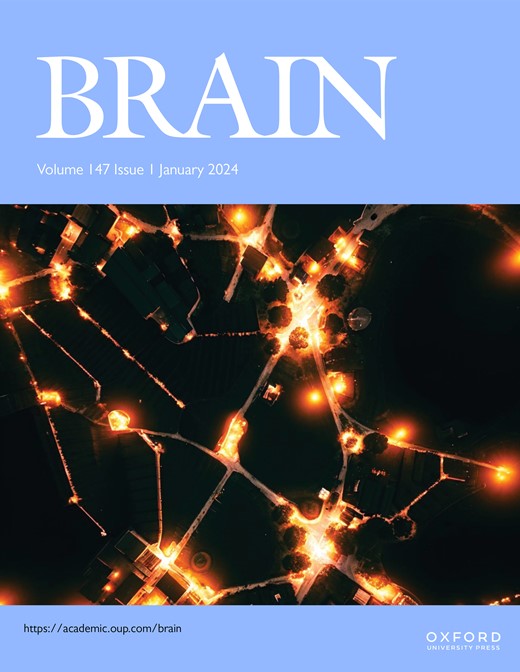Pure autonomic failure: a natural history study of the Queen Square cohort
IF 10.6
1区 医学
Q1 CLINICAL NEUROLOGY
引用次数: 0
Abstract
The current research challenge in pure autonomic failure (PAF) lies in identifying specific biomarkers that can differentiate it from the other Lewy body disorders (Parkinson’s disease, Parkinson’s disease dementia, dementia with Lewy bodies) and multiple system atrophy in the early stages and predict phenoconversion trajectories to more widespread impairment. In this study, we described the natural history of our cohort of PAF patients over five decades and validated a cluster of clinical, autonomic, and neuroimaging biomarkers that help identify clinical profiles susceptible to further neurodegeneration, working towards a biological definition of PAF. Consecutive patients with an initial diagnosis of PAF were recruited and monitored through key milestones (disease onset, first and repeat autonomic assessment, phenoconversion, and death/final contact). A subset underwent brain magnetic resonance imaging and DaTSCAN. Uni- and multivariate regression analyses explored the associations among different factors, survival times, and phenoconversion, and were used to predict the probability of phenoconversion. 281 PAF patients were followed for a median of 10 years. Of these, 33% (91) converted to a more widespread synucleinopathy, and 41% (115) died during follow-up, of whom 53% (61) retained a PAF phenotype. Baseline cardiovascular autonomic biomarkers were key in differentiating disease trajectories and repeat testing indicated worsening of autonomic failure during the disease course. Median survival of PAF patients was 15 years from orthostatic symptoms onset and was mostly influenced by age and the severity of orthostatic hypotension. 39% of patients had abnormal DaTSCAN results up to 7 years before phenoconversion, with 84% of these patients progressing to more widespread synucleinopathy. Male sex, older age, dream enactment behaviour, and supine noradrenaline levels >200 pg/mL were correlated with the risk of phenoconversion to Lewy body disorders, whereas younger age, bladder dysfunction, catheter use, and dream enactment behaviour were associated with phenoconversion to multiple system atrophy. Our natural history study involves the largest single-centre longitudinal cohort of patients with an initial diagnosis of PAF and identifies robust clinical, autonomic, and neuroimaging biomarkers that, when used together, could serve as a novel and sensitive screening tool for early identification and stratification of patients at risk of phenoconversion to more widespread synucleinopathy.纯自主神经衰竭:皇后广场队列的自然历史研究
目前纯自主神经衰竭(PAF)的研究挑战在于确定特异性生物标志物,将其与其他早期路易体疾病(帕金森病、帕金森病痴呆、路易体痴呆)和多系统萎缩区分出来,并预测表型转化轨迹到更广泛的损害。在这项研究中,我们描述了五十多年来PAF患者的自然病史,并验证了一组临床、自主神经和神经成像生物标志物,这些生物标志物有助于识别易受进一步神经变性影响的临床特征,致力于PAF的生物学定义。招募初始诊断为PAF的连续患者,并通过关键里程碑(疾病发病、首次和重复自主神经评估、表型转化和死亡/最后接触)进行监测。一部分患者接受了脑磁共振成像和DaTSCAN。单变量和多变量回归分析探讨了不同因素、生存时间和表型转化之间的关系,并用于预测表型转化的概率。281例PAF患者随访时间中位数为10年。其中,33%(91)转化为更广泛的突触核蛋白病,41%(115)在随访期间死亡,其中53%(61)保留了PAF表型。基线心血管自主神经生物标志物是区分疾病轨迹的关键,重复测试表明在疾病过程中自主神经衰竭恶化。PAF患者的中位生存期为15年,主要受年龄和体位性低血压严重程度的影响。39%的患者在表型转化前7年有异常的DaTSCAN结果,其中84%的患者进展为更广泛的突触核蛋白病。男性、年龄较大、做梦行为和仰卧位去甲肾上腺素水平(gt; 200pg /mL)与表型转化为路易体疾病的风险相关,而年龄较小、膀胱功能障碍、导尿管使用和做梦行为与表型转化为多系统萎缩相关。我们的自然病史研究涉及了最大的单中心纵向队列患者,这些患者最初诊断为PAF,并确定了强大的临床、自主神经和神经成像生物标志物,当这些生物标志物一起使用时,可以作为一种新颖而敏感的筛查工具,用于早期识别和分层具有表型转化为更广泛的突触核蛋白病风险的患者。
本文章由计算机程序翻译,如有差异,请以英文原文为准。
求助全文
约1分钟内获得全文
求助全文
来源期刊

Brain
医学-临床神经学
CiteScore
20.30
自引率
4.10%
发文量
458
审稿时长
3-6 weeks
期刊介绍:
Brain, a journal focused on clinical neurology and translational neuroscience, has been publishing landmark papers since 1878. The journal aims to expand its scope by including studies that shed light on disease mechanisms and conducting innovative clinical trials for brain disorders. With a wide range of topics covered, the Editorial Board represents the international readership and diverse coverage of the journal. Accepted articles are promptly posted online, typically within a few weeks of acceptance. As of 2022, Brain holds an impressive impact factor of 14.5, according to the Journal Citation Reports.
 求助内容:
求助内容: 应助结果提醒方式:
应助结果提醒方式:


